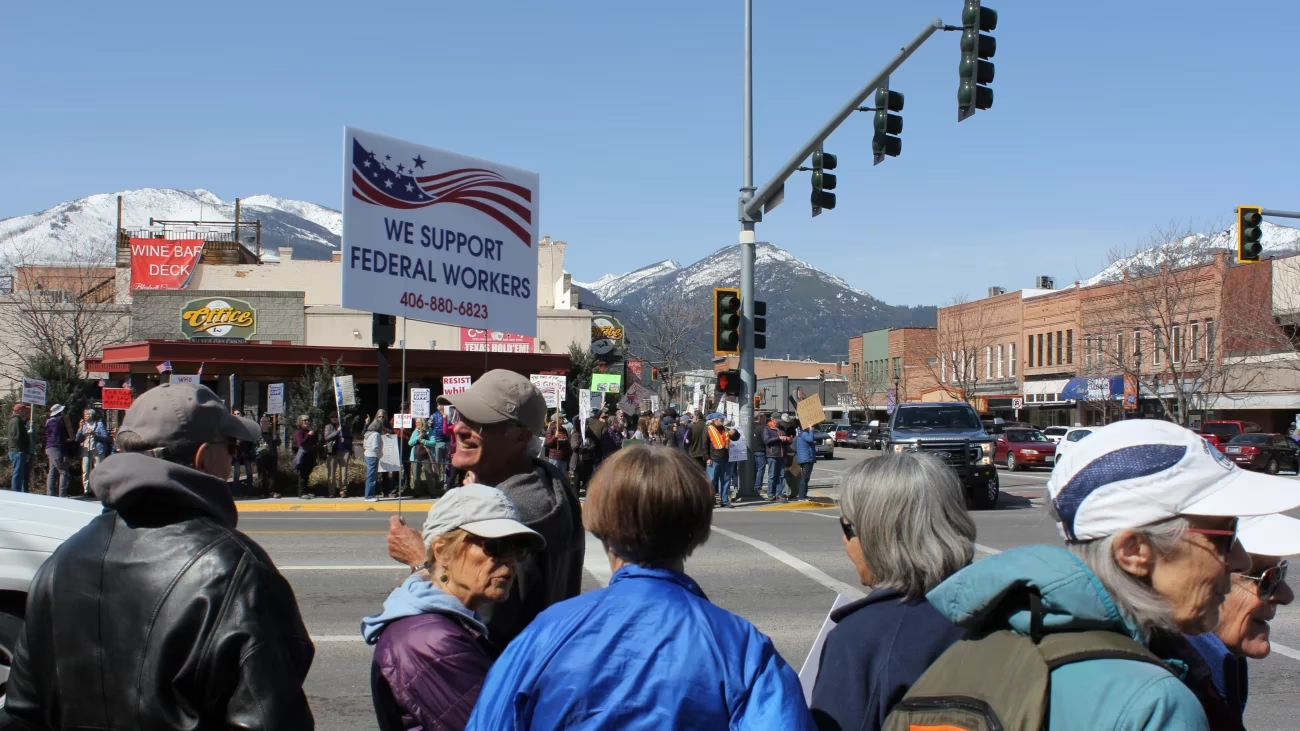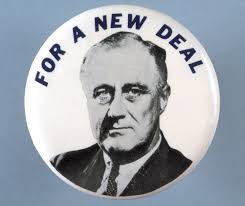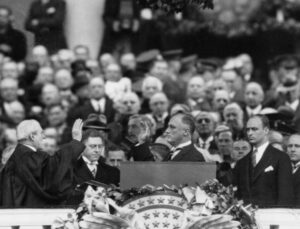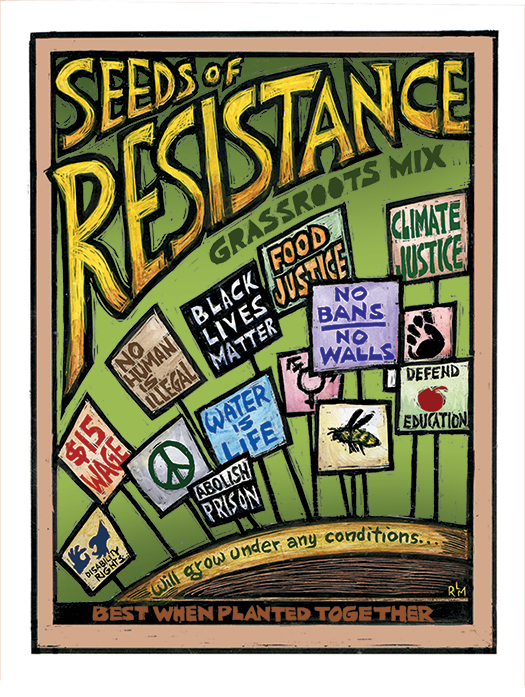[FDR] changed the relationship between government, business and labor forever.
—Doris Kerns Goodwin
The Unraveling of the New Deal, Part 2
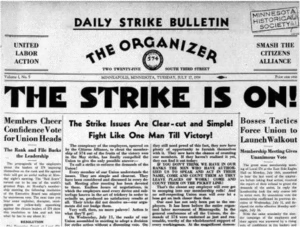
The Minneapolis Teamster’s Strike, 1934
Labor and Civil Rights and Civil Liberties
Civil Rights and Civil Liberties are so much a part of Labor History in the United States that while they can also be separate, they are often inextricably tied to Labor in many instances. Immigration is linked to labor history as new immigrants were a labor force often mistreated and therefore became strong labor activists. For Black people the struggle for civil rights was constant and often linked to labor issues.
Some Immigration History and Now
Immigration is another area that Trump is active in, attempting to export as many refugees as possible, often in cases where they are actually in the U.S. legally. One example is Mahmoud Khalil, a young student with a green card who was arrested along with his pregnant wife, a U.S. citizen, for his pro-Palestine protests and activities, whose treatment is meant to make other protesters afraid.
FDR did not single out any particular group of immigrants; he included them all. He recognized the contributions they were making to the U.S. economy and culture. The influx of immigrants was initially primarily from Europe with the exception of the Chinese on the west coast whose labor built the western railroads to connect with the east for rails to cross the continent in the 1860s.
They came from Ireland during the potato famine in the mid 1800s, and many as refugees from Europe after WWI, and were followed by those who came just before and after WWII. In more recent times they have come from countries in Asia as a result of the Vietnam War when many Vietnamese and Hmong came to Minnesota.
The latest waves of immigrants have arrived from the Middle East wars and from Africa. Minnesota now has a large Somali population as many have immigrated due to our wars in their country. Many now are from other African countries as well, where settler colonialism has left them war-torn and the people destitute as multinational corporations from Western multinationals have robbed them of their natural resources and in effect enslaved their people to do hard labor in their mines.
Last, but certainly not least, many Spanish- or Portuguese-speaking people from South and Central America have left their countries to come to the United States, some fleeing from extreme dictatorships as political refugees and others from poor countries to better their economic situations. Their presence is evidenced by the need to have many formal government documents translated into Spanish, as well as Somali and other languages.

“Migrant Mother,” taken by Dorothea Lange in 1936, depicting Florence Owens Thompson, a mother with her children, during the Great Depression. Source: Wikipedia. Photo now is in the Metropolitan Museum of Art.
Many Hispanic people originally came to work in the large farms that grew fruits and vegetables in California. Some even came to Minnesota to work for Green Giant, resulting in an area on the west side of St. Paul where many settled and stayed. The fight of these workers to unionize and to demand decent living accommodations and wages is well-documented in film, song and books that describe their struggle; often they feature union organizers Cesar Chavez and Delores Huerta.
I might also add that the variety of ethnic groups represented as evidenced by the foods available from the many ethnic restaurants here in Minnesota— adding the food of the Black and Native cultures as well—speaks to America being a nation of immigrants, as it has been since the Mayflower.
Trump’s current attacks on immigrants and immigrant rights are massive as he arrests and deports recent immigrants illegally and with cold-hearted precision. There has been information about the treatment of the deportees in, for example, El Salvador where the accommodations are similar to the Nazi death camps in Germany in WWII, if not worse. He is snatching people off the streets, including students, and sending them to an ICE facility in Louisiana that is reported to be the worst in the country with a reputation for prisoner abuse. How he could possibly care about people is beyond comprehension. The contributions of immigrants to American culture, science, and so on are well-documented in books, articles and on the web.
Remembering Tammany Hall of legend in New York City, where the cops were all Irish: they had a stranglehold on the government and they were corrupt. I use that as an example because they were white, although sometimes were considered to be of another race to denigrate them. They also helped immigrants, particularly their own. The contributions of Tammany may have been somewhat negative, but they were not all the Irish who came to America during the famine. Men of Irish heritage fought on both the Confederate and the Union sides during the Civil War. Irish contributions to the culture of song and dance are immeasurable, especially when you live across the Mississippi River in Minneapolis and visit sister city St. Paul on St. Patrick’s Day. Or visit, in my case, my Irish heritage friends who have done so much good in this world, not to mention a brother of theirs who was in the state legislature for many years. These Catholic Sisters of St. Joseph were rightfully honored by St. Paul’s History Theater with a play of their own. The Irish have left their positive imprint all over the United States in spite of prejudice because of their Roman Catholic religion. (“No Irish Need Apply.”)
Now we have the immigrants from the Middle East, Africa, and those from across the southern border from South and Central America who work in the hotels and often as cleaners in various industries. From Somalia: many Somali men are taxi and truck drivers, at least here in Minnesota. Many are Muslims, and have built a number of mosques in Minneapolis and suburbs.
The immigration starting basically during my lifetime includes refugees from Vietnam and then the Hmong; it continues to the present day where many new African immigrants work in senior or rehabilitation facilities as nurses or nurses’ aids along with jobs in industry.
In other words, they are assimilating. And no, I do not see them so often in the suburbs when I visit. I live in the city, but since George Floyd I see them more often than I used to. What is important is to understand the waves of immigrants who have come to this country and the contributions they have made and that not all white immigrants were good people. But then not all were bad either, and Trump’s attempt to lump all immigrants, especially immigrants of color, into one evil group is in itself an evil, as are his deportations: especially the Hispanics that he is deporting right and left and the pro-Palestinian young college students, as he targets especially those who have taken action against genocide in Gaza.
In another racist/white supremacist move he has promised to restore all the monuments, the statues, torn down in the time of George Floyd protests that honored the Civil War Confederates in a glorification of both war and racism.
Of course there is no such thing as one evil race. In the history of the world not only has evil come from all races, including white of course, but also so many of the brilliant people who have made contributions to world culture are from a variety different races; I think particularly of music, poetry and art, but also science, which, because of its nature in work often done away from the public eye, is not acknowledged as often. No one race can claim total superiority. Or total evil either.
Trump’s obsession with The Wall that is between the U.S. and Mexico is not MAGA, not Make America Great Again, but MEGA in the sense of huge as he has ordered new walls built and increased border patrols, a militarization of the border between the U.S. and Mexico.
And he insists on drawing that “color line,” this time against Hispanics: Trump’s father once evicted Woody Guthrie because he couldn’t pay his rent. Woody immortalized it in song.
I suppose that Old Man Trump knows just how much racial hate
He stirred up in that bloodpot of human hearts
When he drawed that color line
Here at his Beach Haven family project
Beach Haven ain’t my home!
No, I just can’t pay this rent!
My money’s down the drain,
And my soul is badly bent!
Beach Haven is Trump’s Tower
Where no black folks come to roam,
No, no, Old Man Trump!
Old Beach Haven ain’t my home!
But Trump of course is not alone in his efforts to destroy the good that America has done, the American values that so many have fought and died for and others have striven to not just preserve but make active and real in our daily lives, and continue to do so.
The 2025 program that Trump embraces was created by the Heritage Foundation. Much of a Republican Congress and some Democrats also support what he is doing as he continues to destroy America: There is no other way to describe it. He stands at the titular head of it all with his narcissism and his greed for approval and power, a W.T. Barnum of politics as he centers himself in “the greatest show on earth” as the American Empire crumbles.
Black People Under FDR
FDR did more for Black people than any previous president. He had what was called a Black Cabinet that was involved in labor. The Black Cabinet was an unofficial group of African-American advisors to FDR. They ensured that thousands of Black women and men received the training that enabled them to work in the defense industry during World War II. And while helping reverse segregation in the federal workforce, they brought about the first anti-discrimination clauses in government contracts.
Lynching Law
Although not related directly to labor, the Roosevelt connection to a lynching law also needs to be mentioned. A law against lynching was controversial at the time, although Eleanor Roosevelt was an avid supporter of creating a federal law against it. She even arranged a meeting between Walter White of the NAACP and FDR. White was an American civil rights activist who led the National Association for the Advancement of Colored People (NAACP) for a quarter of a century, from 1929 until 1955. White directed a broad program of legal challenges to racial segregation and disfranchisement. But because of the southern senators who could block bills that FDR favored, especially Social Security, even though in private he expressed opposition to lynching, it took many years before a federal law took effect. (Ken Burns: The Roosevelts, Episode 5, PBS.) President Biden signed a federal bill making lynching a hate crime on March 29, 2022.
“The Spirit of the “People”
The spirit of the New Deal, with its emphasis on the people, a government “of the people, by the people, and for the people,” was not a government for what FDR called the “Economic Royalists,” who held power over the people. Today one name for them is the “ruling elite.” It is true that the U.S. Constitution as originally conceived favored white male landowners. That bias has to some extent been preserved; the white moneyed elite that today takes form in racism as white supremacists as personified by the Ku Klux Klan and in other racist myths that elevate the white race as superior. We currently have a president, with his fascist cohorts in Congress, leading in racist threats and comments and with exporting many people who have sought refuge and a better life in the United States.
In the writing of the Constitution there were long and serious debates about the status of the Negro and the three-fifths compromise made that was clearly based on economic considerations of the time. Cotton was King and a major part of the economy, which succeeded on the plantations thanks to Black slave labor. The rights of women and of indigenous people were ignored.
The movements and strikes around civil rights and liberties for people of color, for women, and for labor rights led to large protests early on and continue. often related to the right to unionize regarding pay and working conditions, no small thing.
Paul Robeson singing about Joe Hill, a labor organizer who was accused of murder and executed in 1915 and who is still remembered as an inspiration for labor organizers.
From the Chicago Haymarket Affair, a protest for an 8-hour workday in Chicago on May 4, 1886, to the organizing of the Hispanic farm workers in California in the 1960s and ‘70s for their right to unions, decent pay, and good working conditions. Today organizing continues to create unions in some professions or demand better pay and working conditions, as strikes have become a method to make demands of employers in the public sector and of corporations.
Many unions went on strike during and after WWI and after WWII into the ‘20s, ‘30s, and ‘40s and ‘50s, and they have continued along with other forms of Union building. The history of strikes in the U.S. is well-documented in books, articles. songs, and online on the web.
Judy Collins sings Bread and Roses. The slogan “Bread and Roses” originated in a poem of that name by James Oppenheim, published in American Magazine in December 1911, which attributed it to “the women in the West.” It is commonly associated with the textile strike in Lawrence, Massachusetts during January to March 1912, now often known as the “Bread and Roses strike.” The strike, which united dozens of immigrant communities under the leadership of the Industrial Workers of the World, was led to a large extent by women.
In the Twin Cities we have an annual labor celebration to remember the strike of 1934 and other labor history. The writer Meridel LeSueur, who participated as a young woman in the 1934 Minneapolis Teamster strike later wrote, “No one can be neutral in the face of bullets ” in one of her short books, I Was Marching. She had joined the women working in the kitchen during the strike. As Minneapolis was a transportation center at the time, the strike attracted national attention. Two protesters were killed in that strike and 67 injured by the police.

A food line by the women’s auxiliary during the Teamster’s Strike. Photo: International Brotherhood of Teamsters
Meridel LeSueur was blacklisted during the McCarthy era in the 1950s for her revolutionary writing.
Collective Bargaining
Collective bargaining is the process in which working people, through their unions, negotiate contracts with their employers to determine their terms of employment, including pay, benefits, hours, leave, job health and safety policies, ways to balance work and family, and more.
According to the AFL-CIO, in 1935 the National Labor Relations Act clarified the bargaining rights of most private-sector workers and established collective bargaining as the “policy of the United States.” While it had been used in earlier strikes, it was not a federal law until 1935 during Roosevelt’s first term.
In 1935, the National Labor Relations Act clarified the bargaining rights of most other private-sector workers and established collective bargaining as the “policy of the United States.” The right to collective bargaining also is recognized by international human rights conventions.
The freedom to form and join a union is core to the U.N. Universal Declaration on Human Rights and is an “enabling” right—a fundamental right that ensures the ability to protect other rights.
Eleanor Roosevelt was the Chairperson of the U.N. Commission on Human Rights that wrote the Declaration, and she contributed to its writing. The Universal Declaration of Human Rights (UDHR) was adopted by the United Nations General Assembly on December 10, 1948.
Flash Forward. March/April 2025
Statement from the AFL-CIO
Trump and Musk are trying to destroy the right of collective bargaining. It’s on their list of practices that are “unfriendly” to corporate autocratic domination of America.
March 27, 2025
AFL-CIO President Liz Shuler issued a statement on a new executive order from the Trump administration stripping collective bargaining and union rights from workers across the federal government:
Straight out of Project 2025, this executive order is the very definition of union-busting. It strips the fundamental right to unionize and collectively bargain from workers across the federal government at more than 30 agencies. The workers who make sure our food is safe to eat, care for our veterans, protect us from public health emergencies and much more will no longer have a voice on the job or the ability to organize with their coworkers for better conditions at work so they can efficiently provide the services the public relies upon. It’s clear that this order is punishment for unions who are leading the fight against the administration’s illegal actions in court—and a blatant attempt to silence us Trump and Musk have now declared war on collective bargaining, and the AFO-CIO has reacted as they have joined in civil resistance to the daredevil duo’s many undercuttings of the rights of the people, who they are attacking.
March, 2025
The following is a statement that supports the United Farm Workers:
We are in scary times. As we told you, even before Trump was inaugurated, a huge immigration operation has already begun in rural farm worker areas of Kern County, one of the top five most productive US agricultural counties. Border Patrol traveled 300+ miles from the US-Mexico border to profile the people who work so hard to harvest our food.
Then Trump was inaugurated. On his first day, he signed frightening Executive Orders including on immigration—which are terrifying farm workers and their families who are already badly shaken up from these raids that appeared to come out of nowhere. We immediately began having “Know Your Rights” sessions for farm workers throughout CA and producing “Know Your Rights” materials that we are distributing and sharing on social media and our website. As we’ve been dealing with this, many of our offices have received hate mail from “Trump’s Coming” with no return address. They say, “Report illegal aliens at schools, at work, at church, at restaurants, in your neighborhood … There is nowhere to hide!” We are not allowing these fear and intimidation tactics to stop us from doing our priority work of letting farm workers know that regardless of their immigration status they have rights. Our organizers are in the fields and communities sharing the resources we’ve been rushing to put together.
March 28, 2025
Statement from UAW [United Auto Workers] President Shawn Fain on Attacks on Federal Workers
Yesterday, President Trump signed an order that tramples on the union rights of more than a million federal workers, stripping them of their ability to negotiate over their working conditions. The 1 million members of the UAW stand with federal workers and their union, AFGE, against the attacks from the Trump administration.
Update: April 25, 2025
Summary
- Order exempting agencies from bargaining blocked pending lawsuit
- Trump said order was necessary to protect national security
- Unions claim retaliation for legal challenges to Trump policies
April 25 (Reuters) – A federal judge on Friday temporarily blocked the administration of President Donald Trump from stripping hundreds of thousands of federal employees of the ability to unionize and collectively bargain over working conditions.
Senior U.S. District Judge Paul Friedman in Washington, D.C., blocked an executive order Trump issued in March from being implemented pending the outcome of a lawsuit by the National Treasury Employees Union, which represents about 160,000 federal employees.
AFL-CIO President Applauds Ruling to Restore Federal Workers’ Collective Bargaining Rights
AFL-CIO President Liz Shuler issued the following statement on a ruling from the U.S. District Court for the District of Columbia in case brought by the National Treasury Employees Union (NTEU) blocking the Trump administration’s executive order that illegally stripped thousands of federal workers of their collective bargaining rights:
We commend the court for recognizing the Trump administration’s executive order stripping collective bargaining rights for what it was: illegal, retaliatory union-busting. This was the most significant attack on workers’ rights in history, and if Trump was allowed to do it to federal workers, he would be able to do it to every worker in America, in every workplace and every industry. So this ruling to restore federal workers’ collective bargaining rights and reinstate their existing contracts—even if temporarily while the case continues in court—is an important first step.
But this fight isn’t over, and it isn’t limited to the courts. Every member of Congress who stands with working people needs to support and vote to pass the Protecting America’s Workforce Act (H.R. 2550), a bill that would reverse this outrageous executive order and restore workers’ union contracts. We won’t rest until this illegal order is struck down once and for all.
May 16, 2025, Litigation Continues
A federal appeals court has cleared the way for President Donald Trump‘s executive order to move forward, aiming to curtail collective bargaining rights for hundreds of thousands of federal workers while litigation continues.
***
In a 2-1 decision, a panel of judges in Washington, D.C., ruled that unions representing federal employees lack standing to sue. The majority cited the administration’s assurance that no existing collective bargaining agreements would be terminated during the ongoing legal proceedings.
Judges Karen Henderson, appointed by former President George H.W. Bush, and Justin Walker, appointed by Trump, supported the ruling; Judge Michelle Childs, appointed by former President Joe Biden, dissented.
[FDR] changed the relationship between government, business and labor forever.
—Doris Kerns Goodwin, Ken Burns: The Roosevelts,
Episode 5, PBS

Featured image:
“Hundreds of people join a protest in downtown Hamilton, Mont., in April supporting the work of federal employees as President Donald Trump oversees efforts to restructure the nation’s government. Federal scientific research and forestry work are part of this small town’s economic bedrock.” Photo: Katheryn Houghton/KFF Health News
The Unraveling of the New Deal
END OF PART 2




